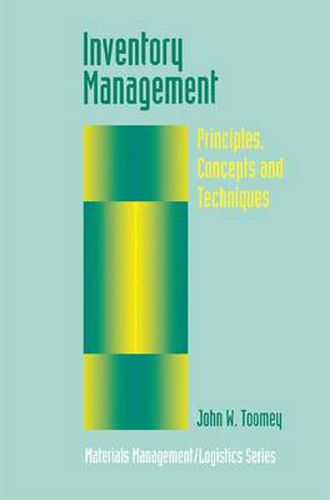Readings Newsletter
Become a Readings Member to make your shopping experience even easier.
Sign in or sign up for free!
You’re not far away from qualifying for FREE standard shipping within Australia
You’ve qualified for FREE standard shipping within Australia
The cart is loading…






This title is printed to order. This book may have been self-published. If so, we cannot guarantee the quality of the content. In the main most books will have gone through the editing process however some may not. We therefore suggest that you be aware of this before ordering this book. If in doubt check either the author or publisher’s details as we are unable to accept any returns unless they are faulty. Please contact us if you have any questions.
The goal of Inventory Management will be to explain the dynamics of inventory management’s principles, concepts, and techniques as they relate to the entire supply chain (customer demand, distribution, and product transformation processes). The interrelationships of all functions will be defined. The book concentrates on understanding the many ramifications of inventory management. In today’s competitive business environment, inventory management has proven to be most critical, and this book is directed to the management of inventory to assist in better understanding the body of knowledge required to operate in a competitive world. Almost all functions such as sales, engineering, and accounting have an impact and are impacted by inventory management. The book will assist in the training of students as well as APICS CPIM (Certified in Production and Inventory Management) candidates. As such it will not only be a textbook, but also a desk reference for those employees responsible for controlling inventories, and thereby assist in reducing cost, improving customer service, and maximizing capacity.
Each chapter concludes with a case study and suggested solution. The case studies tell the story of a growing company, Smith Industries, and the related inventory management problems it had to address. The problems addressed relate to the subject matter of the chapter.
$9.00 standard shipping within Australia
FREE standard shipping within Australia for orders over $100.00
Express & International shipping calculated at checkout
This title is printed to order. This book may have been self-published. If so, we cannot guarantee the quality of the content. In the main most books will have gone through the editing process however some may not. We therefore suggest that you be aware of this before ordering this book. If in doubt check either the author or publisher’s details as we are unable to accept any returns unless they are faulty. Please contact us if you have any questions.
The goal of Inventory Management will be to explain the dynamics of inventory management’s principles, concepts, and techniques as they relate to the entire supply chain (customer demand, distribution, and product transformation processes). The interrelationships of all functions will be defined. The book concentrates on understanding the many ramifications of inventory management. In today’s competitive business environment, inventory management has proven to be most critical, and this book is directed to the management of inventory to assist in better understanding the body of knowledge required to operate in a competitive world. Almost all functions such as sales, engineering, and accounting have an impact and are impacted by inventory management. The book will assist in the training of students as well as APICS CPIM (Certified in Production and Inventory Management) candidates. As such it will not only be a textbook, but also a desk reference for those employees responsible for controlling inventories, and thereby assist in reducing cost, improving customer service, and maximizing capacity.
Each chapter concludes with a case study and suggested solution. The case studies tell the story of a growing company, Smith Industries, and the related inventory management problems it had to address. The problems addressed relate to the subject matter of the chapter.